- Home
- A-Z Publications
- CNS & Neurological Disorders - Drug Targets (Formerly Current Drug Targets - CNS & Neurological Disorders)
- Previous Issues
- Volume 18, Issue 10, 2019
CNS & Neurological Disorders - Drug Targets (Formerly Current Drug Targets - CNS & Neurological Disorders) - Volume 18, Issue 10, 2019
Volume 18, Issue 10, 2019
-
-
Omega-3 Fatty Acids as Druggable Therapeutics for Neurodegenerative Disorders
More LessAuthors: Neha M. Chitre, Nader H. Moniri and Kevin S. MurnaneNeurodegenerative disorders are commonly associated with a complex pattern of pathophysiological hallmarks, including increased oxidative stress and neuroinflammation, which makes their treatment challenging. Omega-3 Fatty Acids (O3FA) are natural products with reported neuroprotective, anti-inflammatory, and antioxidant effects. These effects have been attributed to their incorporation into neuronal me Read More
-
-
-
Pharmacotherapy of Down’s Syndrome: When and Which?
More LessAuthors: Seyed K. Tayebati, Alessandro Cecchi, Ilenia Martinelli, Elisa Carboni and Francesco AmentaDown Syndrome (DS) is an essential genetic disease that involves many other body systems along with cerebral functions. The postnatal approach to treat this genetic disease includes intervention on various related disorders (e.g., heart failure, respiratory, oral, ear, and hearing disorders). However, different proposed treatments do not significantly improve the quality of life of these subjects. Another approach to the treat Read More
-
-
-
Neurobehavioral Consequences Associated with Long Term Tramadol Utilization and Pathological Mechanisms
More LessAuthors: Khadga Raj, Pooja Chawla and Shamsher SinghTramadol is a synthetic analog of codeine used to treat pain of moderate to severe intensity and is reported to have neurotoxic potential. At therapeutic dose, tramadol does not cause major side effects in comparison to other opioid analgesics, and is useful for the management of neurological problems like anxiety and depression. Long term utilization of tramadol is associated with various neurological disorders like Read More
-
-
-
A Review for Lithium: Pharmacokinetics, Drug Design, and Toxicity
More LessAuthors: Jinhua Wen, Darrell Sawmiller, Brendan Wheeldon and Jun TanLithium as a mood stabilizer has been used as the standard pharmacological treatment for Bipolar Disorder (BD) for more than 60 years. Recent studies have also shown that it has the potential for the treatment of many other neurodegenerative disorders, including Alzheimer’s, Parkinson’s and Huntington’s disease, through its neurotrophic, neuroprotective, antioxidant and anti-inflammatory actions. Therefore, exploring its Read More
-
-
-
Structurally Related Edaravone Analogues: Synthesis, Antiradical, Antioxidant, and Copper-Chelating Properties
More LessAuthors: Alexandre LeBlanc, Miroslava Cuperlovic-Culf, Pier Jr. Morin and Mohamed TouaibiaBackground: The current therapeutic options available to patients diagnosed with Amyotrophic Lateral Sclerosis (ALS) are limited and edaravone is a compound that has gained significant interest for its therapeutic potential in this condition. Objectives: The current work was thus undertaken to synthesize and characterize a series of edaravone analogues. Methods: A total of 17 analogues were synthesized and characterized for Read More
-
-
-
Somatostatin Type 2 Receptor Antibody Enhances Mechanical Hyperalgesia in the Dorsal Root Ganglion Neurons after Sciatic Nerve-pinch Injury: Evidence of Behavioral Studies and Bax Protein Expression
More LessAuthors: Qiong Xiang, Jing-Jing Li, Chun-Yan Li, Rong-Bo Tian and Xian-Hui LiBackground: Our previous study has indicated that somatostatin potently inhibits neuropathic pain through the activation of its type 2 receptor (SSTR2) in mouse dorsal root ganglion and spinal cord. However, the underlying mechanism of this activation has not been elucidated clearly. Objective: The aim of this study is to perform the pharmacological studies on the basis of sciatic nerve-pinch mice model and explore th Read More
-
-
-
Synthesis and Evaluation of N-substituted (Z)-5-(Benzo[d][1,3]dioxol-5-ylmethylene)-2-Thioxothiazolidin-4-one Derivatives and 5-Substituted-Thioxothiazolidindione Derivatives as Potent Anticonvulsant Agents
More LessAuthors: Shiyang Dong, Yanhua Liu, Jun Xu, Yue Hu, Limin Huang and Zengtao WangBackground: Epilepsy is a serious and common neurological disorder threatening the health of humans. Despite enormous progress in epileptic research, the anti-epileptic drugs present many limitations. These limitations prompted the development of more safer and effective AEDs. Methods: A series of N-substituted (Z)-5-(benzo[d][1,3]dioxol-5-ylmethylene)- 2-thioxothiazolidin-4- one derivatives and 5-substituted-thi Read More
-
Volumes & issues
-
Volume 24 (2025)
-
Volume 23 (2024)
-
Volume 22 (2023)
-
Volume 21 (2022)
-
Volume 20 (2021)
-
Volume 19 (2020)
-
Volume 18 (2019)
-
Volume 17 (2018)
-
Volume 16 (2017)
-
Volume 15 (2016)
-
Volume 14 (2015)
-
Volume 13 (2014)
-
Volume 12 (2013)
-
Volume 11 (2012)
-
Volume 10 (2011)
-
Volume 9 (2010)
-
Volume 8 (2009)
-
Volume 7 (2008)
-
Volume 6 (2007)
-
Volume 5 (2006)
Most Read This Month
Article
content/journals/cnsnddt
Journal
10
5
false
en

Most Cited Most Cited RSS feed
-
-
A Retrospective, Multi-Center Cohort Study Evaluating the Severity- Related Effects of Cerebrolysin Treatment on Clinical Outcomes in Traumatic Brain Injury
Authors: Dafin F. Muresanu, Alexandru V. Ciurea, Radu M. Gorgan, Eva Gheorghita, Stefan I. Florian, Horatiu Stan, Alin Blaga, Nicolai Ianovici, Stefan M. Iencean, Dana Turliuc, Horia B. Davidescu, Cornel Mihalache, Felix M. Brehar, Anca . S. Mihaescu, Dinu C. Mardare, Aurelian Anghelescu, Carmen Chiparus, Magdalena Lapadat, Viorel Pruna, Dumitru Mohan, Constantin Costea, Daniel Costea, Claudiu Palade, Narcisa Bucur, Jesus Figueroa and Anton Alvarez
-
-
-
- More Less

